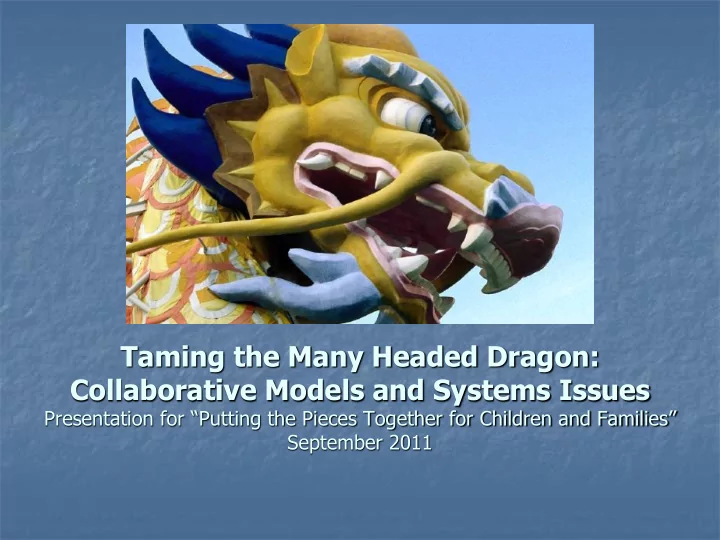

Taming the Many Headed Dragon: Collaborative Models and Systems Issues Presentation for “Putting the Pieces Together for Children and Families” September 2011
Taming the Many Headed Dragon: Collaborative Models and Systems Issues Maria Brereton, Regional Director, Region 1, Department of Children and Families Karen Ohrenberger, Director, Project Safe CT. Department of Mental Health and Addiction Services Marilou Giovannucci, Manager, Court Operations, CT. Judicial Branch
RSVP ~ Short Film on Recovery
CT In-Depth Technical Assistance from the National Center on Substance Abuse and Child Welfare (SAMHSA and ACF) Recovery Specialist Voluntary Program (RSVP)
RSVP A collaboration between: Department of Children and Families (DCF) Department of Mental Health and Addiction Services (DMHAS) Judicial Branch – Court Operations Along with: Advanced Behavioral Health, Inc (ABH) (Non Profit ASO) Office of the Chief Child Protection Attorney (CCPA) Office of the Attorney General
Barriers Identified Parents’ Difficulty Navigating the three major systems: Child Welfare, Substance Abuse Treatment, Court Lack of Communication between the systems; Systems’ frustration with inability to share information because of confidentiality and privacy laws and concerns; Time to treatment vs. ASFA timelines
IDTA/RSVP Shared Principle To improve Safety and Permanency for children when parental substance abuse has been identified as a significant issue resulting in children being removed from their homes.
Goals of the RSVP Agency Collaboration Implement a recovery oriented integrated system of care for families that addresses multi-system policies, procedures and practices resulting in improved access to services and collateral supports; Increasing the systems’ capacity to better serve families impacted by substance use disorders through improved communication and information exchange among systems, practitioners, communities, consumers and families; Facilitating ongoing communication and collaborative problem resolution for concerns and issues raised by the parties.
Goals of Collaboration (continued) Developing a system of joint, multidisciplinary training that promotes cross-agency understanding of evidence- based interventions, children’s mental health, child development and well-being, the impact of substance abuse/dependency on parenting, and culturally and gender- appropriate service delivery; Establishing mechanisms that promote more timely access to information across systems resulting in improved individual, program and system outcomes.
English Translation ~ Goals of RSVP Help parents navigate the DCF, Court and Provider systems Establish one definition of substance abuse treatment and recovery Help the systems talk to each other Do it fast
RSVP Project Structure Over sight by Agency Commissioners and Chief Administrative Judge CORE TEAM Leadership from DCF, DMHAS & Court
RSVP Development of Recovery Specialist Voluntary Program CORE Team Policies and Practice Information Sharing Staff Development Resources
RSVP CORE Team Members traveled to Sacramento. STARS Model introduced to CT IDTA Members. Memorandum of Understanding between systems developed. Stakeholder Input and Cross-training Events Held
RSVP Recovery Specialist Voluntary Program Policy and Practice Model Developed and Implemented Voluntary program offered to parents whose child(ren) is removed by court order as a result of alleged abuse or neglect and substance abuse is a significant factor in the removal. RSVP introduced to Parent at the first Court Hearing on the Temporary Removal Order. SAMSS meeting in each area office
RSVP DCF Area Offices/Juvenile Courts Pilot Sites New Britain – Urban/Suburban Bridgeport - Urban Willimantic – Rural
RSVP Parent must sign “Agreement to Participate in RSVP” and Releases of Information. “Agreement to Participate” and program expectations become “Standing Order.” Recovery Specialist is assigned to Parent at the Court.
RSVP DCF completes a preliminary assessment using GAIN Short Screen; Parent referred to Substance Abuse Assessment by DCF; Level of Care and other service needs identified.
RSVP Recovery Specialist The Recovery Specialist, working with DCF, the substance abuse treatment provider and the Juvenile Court to reduce the burden on the parent by facilitating treatment. RS provides coaching, advocacy and support for the parent; Not a DCF or Court employee.
RSVP Recovery Specialists: ABH Staff, Supervised by Program Manager Assist parents in engaging in SA treatment. Conduct reliable random drug screens. Support parents in increasing their recovery capital through recovery coaching. Provide regular documentation to DCF, courts, and attorneys.
Substance Abuse Managed Service System ( SAMSS) Facilitated by DCF with active participation from DMHAS, ABH and local treatment providers Case overview presented by DCF SW Review evaluation findings and recommendations Develop a plan of action through collaborative problem solving and resource identification Community Networking
RSVP Client presented/followed at SAMSS for coordination of services. Progress reviewed monthly during Case Status Conferences in Court conducted by the Court Services Officer (CSO).
OUTCOMES Policy to Practice Model Budget neutral programming - Redirected funds from other sources Jointly funded program evaluation DCF/DHMAS/Court Improvement – cross training Time to treatment, drug testing, reunification/permanency Timely case resolution that we hope results in cost savings
Unanticipated Positive Outcomes Needs across systems were identified and addressed. Two examples: RCM preventive strategy-keep kids home/prevent removal/recovery support Collaboration with the Women and Children's programs; Created a problem solving environment; Created and sustain respectful relationships predicated on the best interest of families; Eliminated the system “silos”. Created an environment of “shared risk”
LESSONS LEARNED Attorney involvement-agency and parents and kids Ongoing Core Team meetings Ongoing communication with local stakeholders Cross site interaction
Materials RSVP Brochure DHMAS Info Brief Memorandum of Agreement Standing Order Agreement to Participate Court Protocol Recovery Specialist Job Description ABH Biannual Report
Contact Us Maria Brereton Maria.Brereton@ ct.gov Karen Ohrenberger Karen.Ohrenberger@po.state.ct..gov Marilou Giovannucci Marilou.Giovannucci@jud.ct.gov
Parting Words “ Together we embrace safety, permanency, substance abuse treatment and recovery. Our ultimate goal is to achieve positive results for a family that will last a lifetime.”
Recommend
More recommend